How to Calculate Solar Panel and Battery for CCTV System
- Richard Wang
- May 26, 2022
- 1:01 pm

Table of Contents
1. Typical Solar Powered CCTV Camera Scenario
CCTV systems often need to be deployed in some remote areas, and these areas are often difficult to obtain stable power from utility power. In this case, solar energy is often the best alternative. This article mainly describes how to calculate solar panel and battery for CCTV system in this scenario. This article mainly simplifies the calculation scheme in order to solve the problem of engineering implementation.

The above picture is our common CCTV Camera scenario. What you encounter may be slightly different from this scenario, it doesn’t matter, you just need to adjust it according to yours. To perform the task of calculating ups and battery, it is important to first pick out the active device and passive device in the entire system.
Active device is simply understood as a device that needs power consumption. For example camera, POE switch. Note that the power system itself has some power loss.
Passive device we understand as a device that does not consume power. Such as fiber panel.
It is very important to calculate the max power of all active devices for how to calculate solar panel and battery for CCTV system.
When we have identified all active devices, first list a table as follows:
Table 1-Active Device Max Power
|
Quantity (PCS) |
Max Unit Rated Power(W) |
Max Total Rated Power(W) |
|
|
Bullet Camera |
1 |
? | ? |
|
PTZ Camera |
1 |
? | ? |
|
POE Switch |
1 |
? | ? |
|
UPS Self Consumption |
1 |
? | ? |
|
Total Rated Power |
|||
2.Step-1 Find Out Active Device Max Power
2.1 Camera Max Power
In the solar scenario, in order to calculate solar panel and battery for CCTV system, we need to be careful to find all active devices, not to miss them. Because this will greatly affect the configuration of the battery and solar panel.
Different active devices have different maximum powers, which can be queried on the catalogs of different devices.
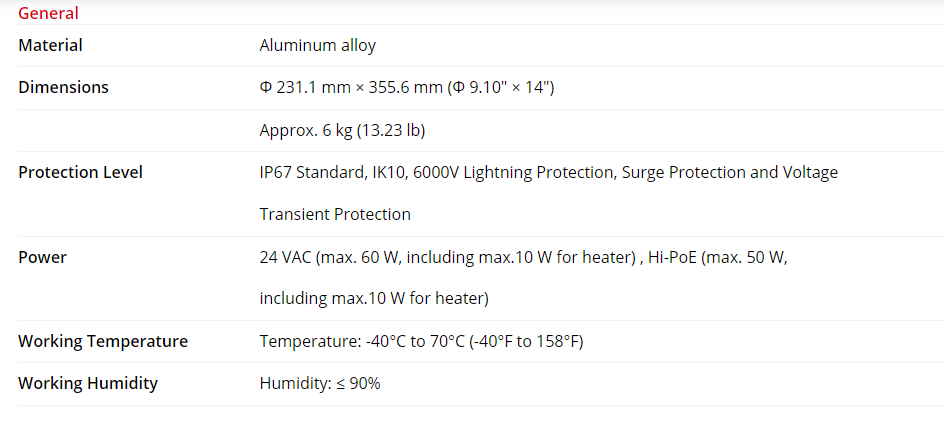
This is the power parameter of a typical camera. We can see that this camera needs a maximum of 50W when using Hi-POE, and 10W when using heater.
Through the catalogs of different devices, we can find the parameters of this max power.
2.2 POE Switch Max Rated Power
For POE switches, the parameter identifications of different manufacturers are different. What we need to pay attention to is that the maximum power consumption of the POE switch itself in standby and running status is not including the POE providing part. Because the POE itself powers the camera, so the power consumption they consume has been calculated in the previous chapter.

However, it should be noted that different manufacturers have different way of writing for POE switch max power. The above picture is a typical situation where the standby and running power consumption of the PoE switch itself is not clearly marked. But based on their identities, we can speculate:
Standby<5W, Full Load<120W
120W means that the POE+ system can provide a maximum of 120W. For a switch of this level, we basically estimate the maximum power consumption of about 8W in standby and running. Of course this is in the case that this number is not clearly marked on the catalog. But when POE switch manufacturers are clearly marked, use their data as much as possible is better.
2.3 Fill the Active Device Max Power
Based on the above methods, we can obtain the max power of the camera, POE Switch or other active devices. It is assumed here that the maximum power of each device in our scenario is as follows:
Max Power Bullet Camera = 15.4W
Max Power PTZ Camera = 30W
PoE Switch(Self Power Consumption) =8W
UPS Self Consumption=10W
Then we can get our table:
Table 2-Active Device Max Power(Filled)
|
Quantity(PCS) |
Max Unit Rated Power(W) |
Max Total Rated Power(W) |
|
|
Bullet Camera |
1 |
15.4W | 15.4W |
|
PTZ Camera |
1 |
30W | 30W |
|
POE Switch |
1 |
8W | 8W |
|
UPS Self Consumption |
1 |
10W | 10W |
|
Total Rated Power |
63.4W | ||
Then according to the calculation, we finally got the maximum power consumption of the whole system is 63.4W. This data is crucial for us to define how to calculate solar panel and battery for CCTV system.
3.Step-2 Choose the Battery that Suits Your CCTV System
3.1 Choose Your Battery Type Carefully
There are three common types of batteries on the market:
(1) Lead Acid Battery (GeL)
Such batteries are relatively common in the market. The advantage is stability and lower price. The disadvantage is that the suitable operating temperature is 25°C, which is not easy to reach when deployed outdoors. And the charge and discharge cycles of Lead Acid Battery are basically around 600 times. Assuming one charge-discharge cycle per day, the battery needs to be replaced in less than two years.
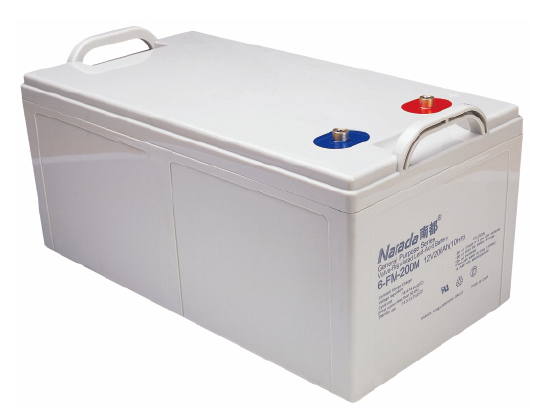
(2) MnNiCo Ternary Lithium Battery
This lithium battery is often used in laptop and mobile phone batteries. The priority is the cost-effective price, and the suitable working temperature can reach 45°C. Even if it is deployed outdoors, as long as the cooling method is appropriate, it will not be affected by the temperature. The charge and discharge cycles of this kind of battery are basically around 800 times. Slightly better than Lead Acid Battery. Assuming one charge-discharge cycle per day, the battery needs to be replaced basically every 2-3 years. For this type of battery, please pay special attention to purchasing brands with reliable quality. Most battery fire accidents are related to MnNiCo Ternary Lithium Battery of poor quality.


(3) LiFePO4 Lithium Battery (LFP Lithium Battery)
This lithium battery is maturely used in various fields such as Telecom and ICT. It has stable performance, long life and slightly higher price. The charge and discharge cycles of this battery can vary from 2000 to 5000. And its working temperature can reach 45°C. Ideal for outdoor solar powered CCTV systems.


Which battery to choose in the actual scenario needs to be designed according to your scene. The following table is our recommendation, but the actual scenario will be more complicated, you can consult Edgeware sales staff:
Table 3-Battery Type Choose Based on Scenario
|
Price |
Working Temperature |
Charge and Discharge Cycles |
Recommended Application Scenarios |
|
|
Lead Acid Battery |
Low |
25°C |
600 Cycles |
The battery is placed indoors and can be easily replaced. |
|
MnNiCo Ternary Lithium Battery |
Medium |
Up to 45°C |
800 Cycles |
The battery is placed in the outdoor cabinet and is easy to replace. |
|
LiFePO4 Lithium Battery(LFP Lithium Battery) |
High |
Up to 45°C |
2000-5000 Cycles Depends on Brand |
The battery is placed in an outdoor cabinet, and it is very inconvenient to replace it. |
3.1 Principle of Battery Capacity-Wh kWh and Ah
The following content is very important to understand how to calculate solar panel and battery for CCTV system, please read it carefully.
After selecting the battery type, we need to start calculating the battery capacity we need. First of all, we need to know that the value to indicate electrical energy is Wh (watt hour) and kWh (killowatt hour). kWh is a common unit that you pay for your electricity bill at home.
1000Wh=1kWh
But we often see Ah in the battery capacity label, which is a bit confusing. Ah means Amp hours. It means how many amps the battery is able to deliver in one hour. So 20AH means 1 hour at 20A or 10 hours at 2A.
Note that the voltage is introduced when we calculate the charge of the battery. For example, there is a 12V100Ah battery, and its power is calculated as follows:
Battery Voltage*Battery Amp Hours =12V*100Ah=1200Wh=1.2kWh
So suppose we have a 48V100AH battery, its power is calculated as follows:
Battery Voltage*Battery Amp Hours =48V*100Ah=4800Wh=4.8kWh
You can find that the same battery is 100AH, the voltage is different, the power is different. When you use different solar systems, according to the different voltage configurations of the batteries required by the solar controller, the voltages of the battery packs you configure are different, but the overall formula for calculating the power is in accordance with:
Battery Voltage*Battery Amp Hours= Battery Electricity Amount
When configuring the battery pack, pay attention to the configuration according to the battery voltage required by the manufacturer.
3.2 Battery Configuration Calculation
When we configure the battery, we first need to clarify the system autonomy time we expect. System autonomy time in the CCTV system scenario refers to how many hours the system can run on the battery when the solar power is not available. This value needs to be set according to the actual situation of the scenario. Setting it too large may put too much CAPEX into the battery. If the setting is too small, it may affect the availability of the system. Generally, the following two situations will cause solar power is not available:
(1) Weather
In general, if the weather is cloudy, rainy, snowy, and other days without sun, the output of solar energy may only be between 10% and 0.1% of the designed capacity, and the system has to rely on batteries to run.
(2) Evening
The night time system must operate 100% on batteries if it needs to operate normally.
The setting of system autonomy time has a great relationship with local weather, rainfall and CCTV system usage scenarios. How to set the system autonomy time we will explain to you in another article.
We assume that a battery of 48 hours of system autonomy time is required, then the battery capacity is calculated as follows:
(1) First calculate the power required to fill the battery
According to Table2-Active Device Max Power(Filled), we have concluded that the maximum power of the system is 63.4W. If we need to maintain 63.4W operation for 48 hours, the power we need is as follows:
Max System Power(Watt)*Time(Hour) =63.4W*48Hours= 3043.2Wh =3.0432kWh
Note that in many cases it is not necessary to calculate according to max power, it can be calculated according to 60-70%, because no device will always run at max power. This time we take the value as 60%, we can get the average system power:
Total Electricity Needed for System Autonomy = 3043.2Wh*60%= 1825.92Wh
(2) Calculate the Amp Hours that need to be configured with batteries
As we mentioned in Section 3.1, Amp Hours are related to voltage. We need to be clear of the battery voltage of the solar controller. Assuming our sollar controller battery voltage is 12V, then we can calculate the battery’s Amp Hours as follows:
Electricity Amount Needed/Solar Battery Voltage=1825.92Wh/12V= 152.16Ah
(3) Pay special attention to reserve 20% more battery capacity than the required battery capacity to avoid deep discharge
We have calculated that a 12V152.16AH battery is required, but this is not the final value. Generally, in order to avoid deep discharge of the battery and prolong the life of the battery as much as possible, we will configure 20% more capacity.
Amps Hour Needed*1.2=152.16Ah*1.2=182.592 Ah
So far we have concluded that we need a 12V 182.592Ah battery. But you can not find this capacity on the market, so let us use one 12V200AH battery.
4.Step-3 Solar Panel Capacity Caculation for CCTV System
4.1. Solar System Working Mechanism
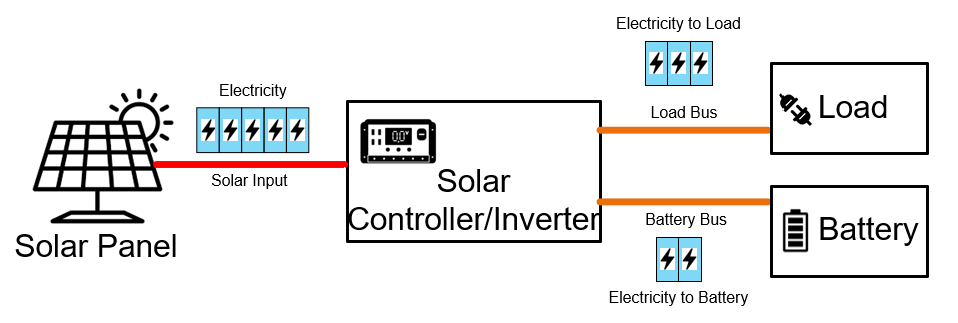
In order to understand how to calculate solar panel and battery for CCTV system, we need to understand the mechanism by how the solar system works.The above figure shows a simplified working principle of the solar controller for easy understanding. When the solar panel generates electricity, the electricity is distributed to the load and the battery through the control of the solar controller. Under normal circumstances, power will be preferentially supplied to the load, and the remaining power will be supplied to the battery to charge. Therefore, when calculating the solar panel capacity, we need to consider that the load needs to consume power, and at the same time, we need to charge the battery.
4.2 Battery Charge Time Key Assumption
First of all, we need to define how long the sunlight time is to fully charge the battery according to the area where the CCTV system is located and the availability requirements of the project. In theory, the shorter the time, the better. You can imagine how bad the availability of the system would be if it took 5 days of sunlight to fully charge the battery. It is very likely that although there are many sunny days, the charging time is too long, causing the battery to enter another rainy day before it is full.
However, if the time required to fully charge the battery is too short, the problem must be that the solar panel has a large capacity configuration. But please note that most of the scenario of the solar powered CCTV system are pole mounted outdoors. Then when you configure a large-capacity solar panel, it will bring a series of problems:
(1) The problem of installing a large-capacity Solar Panel on the pole
The following figure shows the installation of a typical pole mounted solar panel. It is very difficult to install a solar panel with a large capacity on the pole. Installation and maintenance costs will be high.
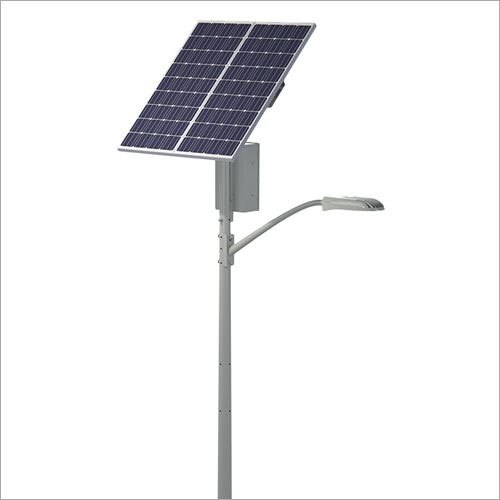
(2) Impact on camera stability
If the solar panel is too big, that will cause vibration of the CCTV camera which is critical issue for the whole system.
(3) Coping with the challenges of strong winds and typhoons
In some areas where there will be strong winds and typhoons, an oversized solar panel will put too much demands on the pole system. thereby greatly increasing the cost.
(4) Ground mounting is not an option most of the time
Installing solar panels on the ground is not feasible in many countries due to safety reasons
Therefore, the configuration of the solar panel capacity should achieve a suitable balance. All technology is a process of compromising and balancing reality.
Generally, we recommend setting the target that charge the battery full in 8-12 hours of sunshine. It also needs to be set according to local conditions and scenarios. Generally, Edgeware’s pre-sales staff will design and discuss with you to arrive at the best solution.
This article sets the battery charge time to 10 hours, based on this setting to explain how to calculate the capacity of the solar panel
4.3 Solar Panel Capacity Calculation
4.3.1 The Data Source Needed for Free
Solar Irradiation
There are many paid tools on the market, but most of them are expensive. Because the total power of the solar powered CCTV system scenario is relatively small, it is not necessary to calculate the data too accurately like the giant solar plant. What we need to do is to qualitatively calculate the needs of the CCTV system scenario.
First of all, we need to know the solar energy resources in the area where the CCTV system is located. The Edgeware pre-sales team obtained this data from solar GIS. Solar GIS solar energy resource query website is as follows:
https://solargis.com/maps-and-gis-data/download/
And the data is free.
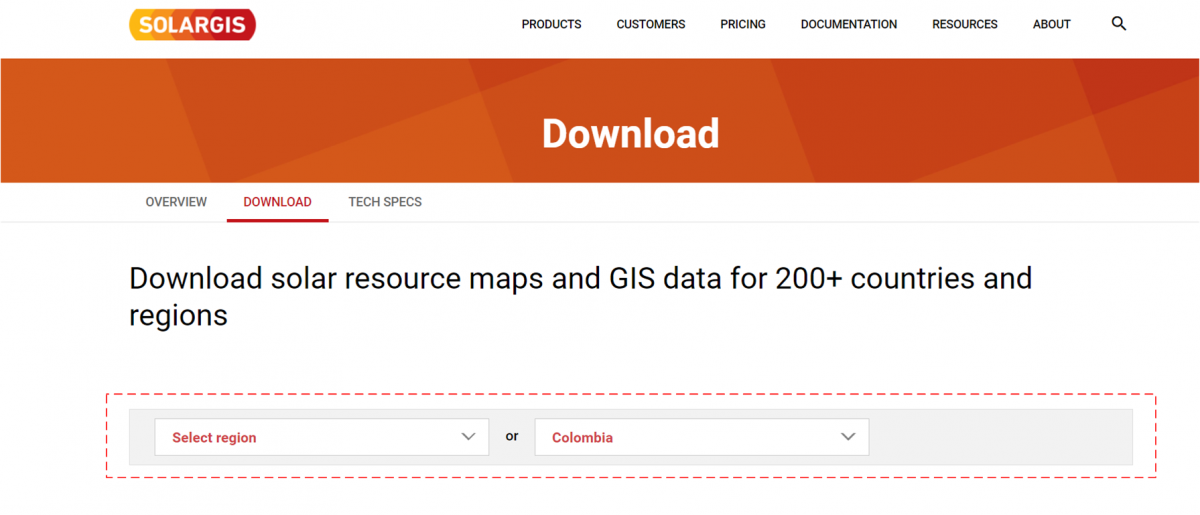
When you select the country where the project is located, you will get the corresponding solar resource map. We assume that this calculation is in Colombia, then we get the following map:
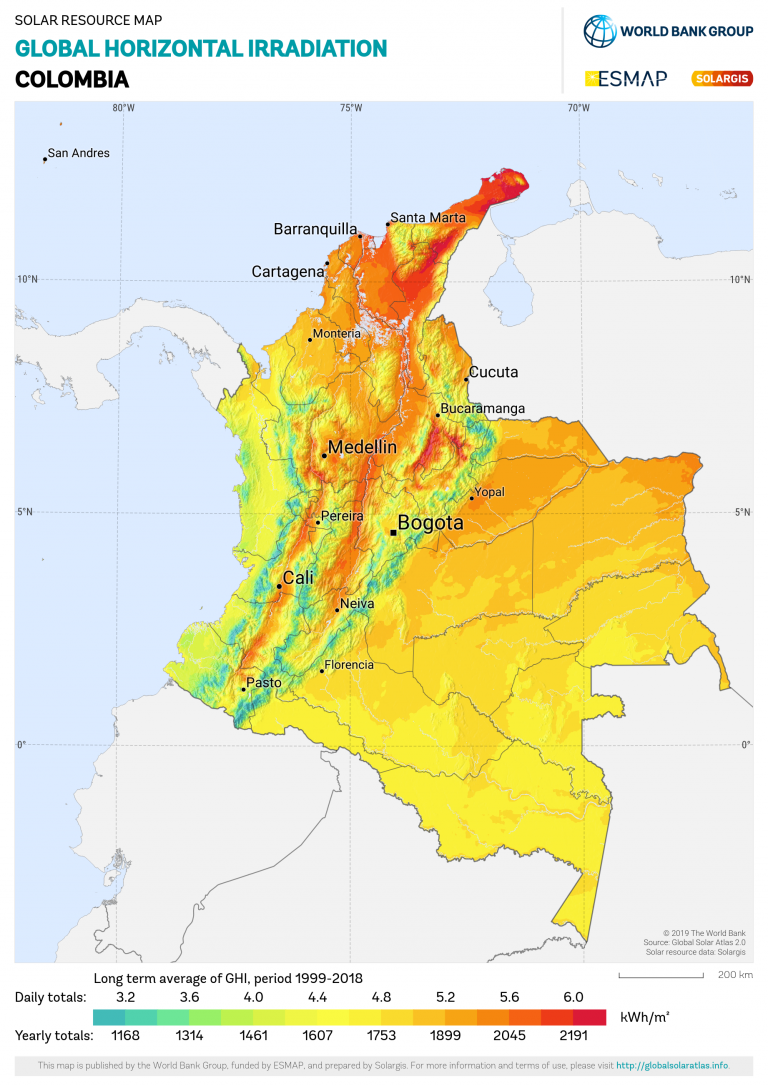
Source : Solar GIS
From the horizontal irradiation of Colombia map we can clearly see the intensity of irradiation in each region. Assuming our site is located in Cartagena, the daily horizontal irradiationtion in this area is around 5.6kWh/㎡ Daily. This value is what we need to use later.
Weather
There are many free websites for weather data, and colleagues at Edgeware are generally used to querying the following free websites:
For example, if we query Cartagena in Colombia, we can get the following data:
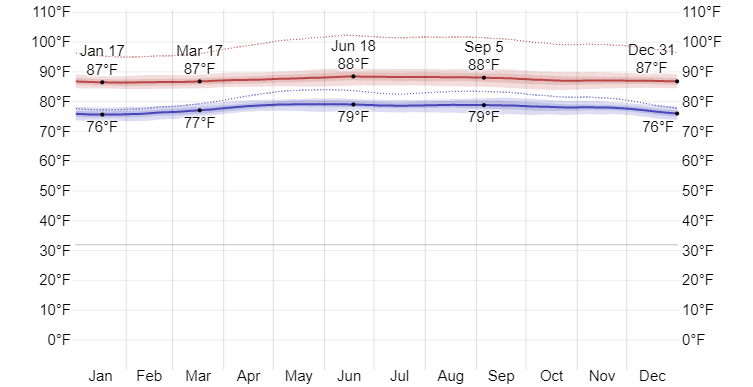

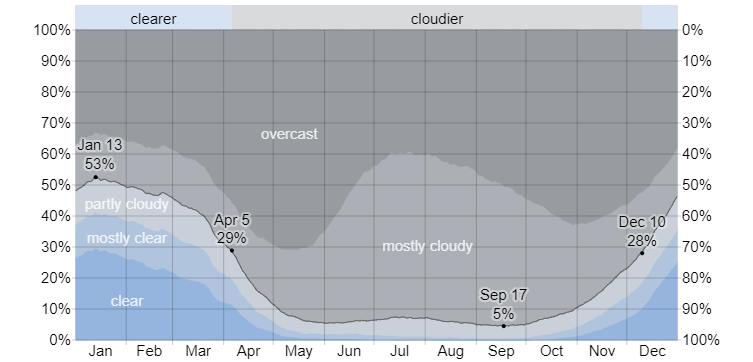
Source Weatherspark
These data are of great reference significance for calculating solar panel and battery for CCTV system:
(1) Temperature
Please pay special attention if the solar powered CCTV system you deploy is below -10ºC or 14°F for any time of the year, it will be below the minimum battery discharge temperature. A heater needs to be deployed to keep the battery at normal operating temperature. Alternatively, an ultra-low temperature working battery can also be configured.
(2) Raining
Based on this data, we can discuss and judge the setting of system autonomy time.
(3) Hours of Daylight and Twilight
According to this time we can deduce the time of sunshine. From the figure, it is about 12 hours, but it is recommended to assume a conservative calculation of 10 hours for subsequent calculations.
4.3.1 Method of Solar Panel Capacity Calculation
First, after our series of data collection and battery calculation just now, we list all the data in a table as follows:
Finally comes to the last step to understand how to calculate solar panel and battery for CCTV system
Table 4-Solar Panel Capacity Caculation Table
|
Max Load Power |
System Autonomy Time |
Battery Capacity Needed |
Battery Charge Time Target |
Horizontal Irradiation On the Site |
Solar Panel Capacity |
|
|
Parameter |
63.4W |
48 Hours |
12V200AH |
10 Hours |
5.6kWh/㎡ |
To be defined |
Total Solar Power Needed
According to our description in chapter 3.1. Solar System Working Mechanism, we need to consider two aspects of power
(1) Battery charging requires power
(2) The power consumption of the system load (in the case of the time with sunlight, the load is powered by solar energy)
First let’s look at the battery, we have a 12V200AH battery, then its total power is calculated as follows:
Electricity Amount of Battery = 12V*200Ah=2400Wh
The maximum system load has been 63.4W, because the system load generally does not always work at the maximum power consumption, we can assume that its average power consumption is 70% of the maximum power:
PLoad=63.4W*70% = 44.38W
Because we assume that the sun shines for 10 hours, then during these 10 hours, the system load is powered by solar energy, and the total electricity required:
Electricity Amount of the Load =44.38W*10Hours = 443.8Wh
So in the end we can get the electricity we need to generate during 10 hours of sun light:
Electricity Amount Gran Total =Electricity Amount of Battery+ Electricity Amount of the Load =2400Wh+443.8Wh = 2843.8Wh
Average solar power we need in 10 hours of light:
PSolar=2843.8Wh/10hours=284.38W
This value is important for our subsequent calculations.
Solar Panel Configuration Calculation
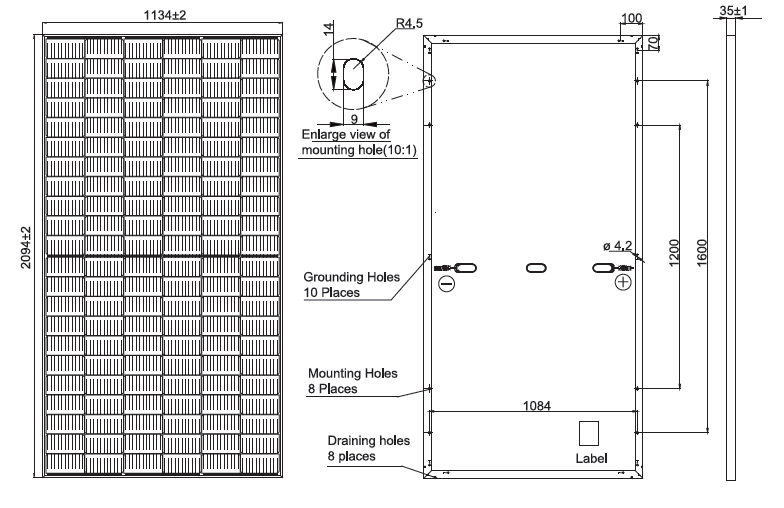
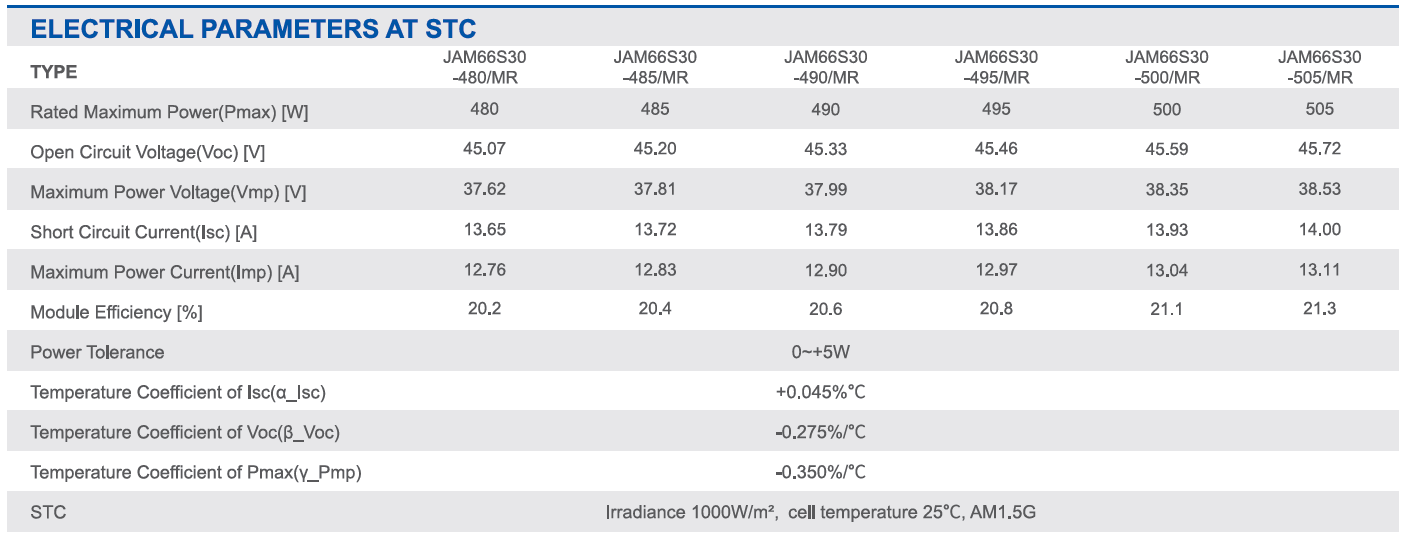
The picture above shows us taking JA Solar’s solar panel as an example. You can see that there is a parameter Module Efficiency, which is very important. We need to know that the radiation of sunlight irradiating the solar panel is not 100% converted into electrical energy. The general conversion efficiency is about 20-21%, and we will take 20.2% for subsequent calculations.
In addition, we have just known that the horizontal irradiation on the site is 5.6kWh/㎡ per day. It can be found that this parameter is related to the area. It’s easy to understand that the larger the area the sun hits, the more energy it gets. The larger the solar panel and the larger the area, the more solar irradiation will be obtained. The area information can be obtained from the solar panel manufacturer’s catalog.
According to the condition that we know that the horizontal irradiation on the site is 5.6kWh/㎡ per day, we can calculate the solar power per square meter:
PSolarSqm =Horizontal Irradiation per Square Meter * Area * Module Efficiency / Sunshine Hours=(5600Wh/㎡ * 1 ㎡ * 20.2%)/10 hours =113.12W
According to the calculations in the previous chapter, the solar power we need is PSolar=284.38W,Then we can figure out how many square solar panels we need:
Solar Panel Area Needed= PSolar/PSolarSqm= 284.38W/113.12W = 2.514 ㎡
According to the situation of the JA Solar solar panel just now, the area of 480W = Width*Height= 2.094m*1.134m=2.375 ㎡
Very close, then we only need to choose a solar panel with a slightly higher efficiency, such as the JAM66S30-505 505W solar panel in the picture above. Note that the calculation of the solar panel does not need to be too accurate, because we are just designing a solar powered CCTV system, and the power itself is very small. But if the system is as large as a solar plant, it needs to be calculated as scientifically as possible.
Then in the end we got the following final parameters, based on which we can start purchasing different originals.
Table 5-Solar Panel Capacity Caculation Table Final
|
Max Load Power |
System Autonomy Time |
Battery Capacity Needed |
Battery Charge Time Target |
Horizontal Irradiation On the Site |
Solar Panel Capacity |
|
|
Parameter |
63.4W |
48 Hours |
12V200AH |
10 Hours |
5.6kWh/㎡ |
505W |
5. Other Special Considerations
Please note that there are some different considerations in different regions. In cold regions where it snows in winter, special attention needs to be paid to whether the surface of the solar panel will be covered after the snow has an impact on the efficiency of the solar panel. In this case, the method of cleaning needs to be considered.
At the same time, in cold regions, when the temperature is lower than -10°C in winter, special attention should be paid to the impact on battery charging and discharging. Heater settings need to be considered. But please don’t forget to consider the power consumed by the heater when calculating the power.
In hot weather areas, the cables from the solar panel to the solar controller may cause large power losses. Consider an extra power budget of 8-10%.
6. Summary
The above is our introduction to how to calculate solar panel and battery for CCTV system, because some simplifications have been made based on the consideration of engineering implementation, please adjust it according to your actual scene. If you have questions, you can also contact Edgeware for more information. At the same time, we are also developing software for automatic calculation to provide to customers. Thanks for reading.

